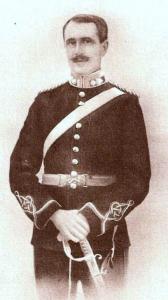
|

|
| Captain Charles Frederick Leonard PIERSON | |
|
114th Heavy Battery, Royal Garrison Artillery Date of birth: 26th February 1883 Date of death: 2nd November 1914 Killed in action aged 31 Buried at Brown’s Road Military Cemetery Plot IV Row B Grave 8 |

|
| Charles Frederick Leonard Pierson was born at 7 Clarence Square, Cheltenham in Gloucestershire on the 26th of February 1883 the only son of Colonel James Frederick Pierson, Royal Artillery, and Susan Mary (nee Finch) Pierson, of 26 the Avenue Eastbourne. He was educated at Lancing College where he won a scholarship and was in Heads House from April to December 1897. He went on to Eastbourne College where he was a Home Boarder from January 1898 to 1899. He was commissioned as a 2nd Lieutenant in the West of Scotland Royal Garrison Artillery (Militia) on the 9th of March 1901 and was promoted to Lieutenant on the 10th of May 1902. On the 24th of December 1902 he was commissioned as a regular officer in the Royal Garrison Artillery with the rank of 2nd Lieutenant. He was promoted to Lieutenant in December 1905 while serving in Malta. On the 7th of December 1907 he was admitted to the Military Hospital, Portsmouth suffering from diphtheria; he returned to duty on the 10th of March 1908. He was married in 1912 to Constance Sybil (nee Ireland); they lived at 22 Western Parade, Southsea in Portsmouth and later at "Montrose", Yarlborough Road, Southsea. Following the outbreak of war he was posted to the 114th Heavy Battery, Royal Garrison Artillery on the 16th of September 1914 and crossed to France with his battery landing at Le Havre on the 4th of October. After a long march, under airplane fire, they arrived at a position near La Bassée. The battery first came into action on the 31st of October and were complemented on their work by their General. Captain Pierson was himself responsible for putting a large German gun out of action at a range of 10,400 yards. On the 2nd of November the battery was near Festubert when it came under heavy German counter battery fire. Charles Pierson was supervising his men into cover when a shell exploded between him and Battery Sergeant Major John Marks Gilbert, killing them both instantly. His wife received the following telegram dated the 5th of November 1914: - "Deeply regret to inform you that Lieut. C.F.L. Pierson RGA was killed in action 2nd Nov. Lord Kitchener expresses his sympathy." He was promoted to Captain after his death, with seniority from the 30th of October 1914. His Battery Commander wrote:- “Lieutenant C.F.L. Pierson was killed in action at Loisnes (near Beuvry) on Nov. 2nd 1914, while the Battery was under heavy shellfire. His death took place early in the shelling, while Lieut. Pierson was endeavoring to get the men of the Battery under cover, this being the first occasion on which taking cover was found necessary. He was seeing the order for taking cover being carried out by all the men before going down himself when the first shell that fell on the battery burst at his feet killing him and the Sergeant Major. Lieut. Pierson was buried near the spot where he died." Another officer wrote:- "We were taken on by a German battery this afternoon, which shelled us very heavily. One round dropped in the middle of the battery. I must tell you-you will be proud to hear it I know-what an excellent officer he was. In every respect he was beyond reproach-a gallant soldier and a brave gentleman. Officer and men alike loved him. I feel his loss terribly; he was the greatest help in every way to me, always cheery and a glutton of work-he never tired." His Commanding Officer wrote:- “I grieve much for his loss, for I have lost an old friend; he was universally popular in the battery. He now lies in a quiet spot in a small orchard, and the men of the battery have bought a wreath of evergreens to put on his grave. He was an excellent officer in every way and a man after my own heart. He took hold of his work, and spared no effort to promote the efficiency of the battery, and had he been spared he would have gone far. We shall never forget him in the battery." He is commemorated on the war memorial at Eastbourne, on the memorial at Eastbourne College and on a plaque in St Mary's Church, Polstead. |
|
| Heads House |
Back